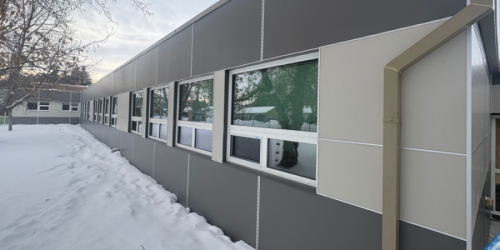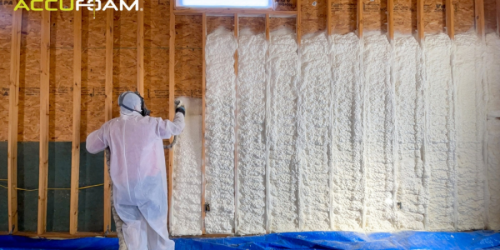Q&A Forums
sprayed from outside Post New Topic | Post Reply
| Author | Comments |
|---|---|
|
Posted: Aug 15, 2009 08:50 AM
|
sprayed from outside
so,,,should i stay or should i go now??? cornfield,,cold climate,,, 2x4 ballon framed,, ext sheeting being removed,, asking for open cell foam sprayed to interior walls from outside,, 1"boardstock to ext for sheeting,, cement hardyboard siding... i am concerned with the airspace between the foam and the foam board stock,,,no matter how full we fill the cavity i wonder... since the foam is not applied to the boardstock will moisture vapor from either direction "look for this next available airspace" to lay down on in the dog days of winter or the hot humid days of summer.... should i do this job this way??? |
|
mason
Posted: Aug 15, 2009 09:20 AM
|
Yes sounds a little risky. You might suggest the specifier have a hygrothermal modeling calculation (WUFI or MOIST) done on the proposed design. I think it will show that some design changes would be in order. If there is a drafty, leaky wall/roof or window fixture I can potentially envision condensation on the cold side of the foam (foam/interior sheathing interface) in the summer months. In the winter months to avoid moisture vapor drive to the outside, you would need to install a vapor retarder element to the exterior surface of the interior sheathing |
|
Posted: Aug 15, 2009 11:19 AM
|
ok,,thinkin on if there is a way,, if i can get them to switch specs to lets say 2.5-3" closed cell,,would this change things,, i realize we would have a pretty good vb on the interior side,,particularly when you factor in the interior coatings,,, i am still suspicious of this airspace between foam face and the exterior sheeting,,,and that this is a balloon framed structure to boot which may exacerbate the convective currents within the wall cavity,,,, |
|
mason
Posted: Aug 15, 2009 05:00 PM
|
Less things to worry about with the closed cell foam. It is its own vapor retarder from the outside and the inside and no worries about any leaks from the roof, windows or walls. |
|
jimcoler
I have over 10 years of experience specifying and installing open and closed cell spray foam. I've sold my business but I'm still selling for the new owners and consulting on large and custom specific jobs. I've expanded my knowledge into t Posted: Aug 17, 2009 12:42 PM
|
I'm not sure if the closed cell will help or hurt in this situation because it would be less likely to let moisture out through the inside and has less moisture capacity to manage moisture overlaods at certain times. The moisture will still slowly seap into the airspaces through the wood studs, but how does it get out if you use closed cell? I would increase the foam board thickness to 2" or more and possibly still use the open cell foam on the inside to allow some moisture vapor out if it gets in. Have to follow the moisture rules: #1 - design to keep the moisture out; #2 - Dssume you'll fail at #1 so design to let it out when it gets in. Just my 2 cents! |
|
Steve Bednarski
Posted: Aug 18, 2009 10:23 PM
|
Noting the desired install routine, spf on the interior wall and foam board stock on the outside as sheathing.... why not use closed cell on the inside and leave the board stock off, or lessen the thickness? As it stands with cc on the interior wall, wouldn't this structure work in the same manner as it has over the last fifty years? If you increase the insulation, air seal, vapor barrier qualities on the backside of the interior walls, you should make that assembly better no matter what. Maybe not perfect, but better, and I cannot see where you would trap any additional moisture within the cavity that it is not used to already, and obviously not problematic. Just my two cents, as it seems that sometimes things get overly technical, and we lose sight of the original goal.... Steve |
|
mason
Posted: Aug 19, 2009 07:38 AM
|
Lets start over: I had two concerns about the original proposal. 1. Bulk water entering the cavity from outside, getting past the siding and the foam sheathing and accumulating in the wall cavity, soaking up the open cell foam 2. Condensation potential from warm moist outside air in the summer getting past the siding and foam sheathing and condensing on the exterior surface of the interior drywall sheathing. I totally agree the best insulation solution is to install the foam board to the interior studs on the outside and spray foam from the inside. Either foam could be used in this application. However, if they are insistent on spraying foam from the outside then I would prefer the close cell foam. Closed cell foam will stop the bulk water from getting into the building (if it got past the siding and the sheathing). But as pointed out any bulk water that got in the cavity space would stand in the wall cavity between the foam sheathing and the foam unless it is directed away with weep holes and flashing to the outside. So I would add those elements to the design if forced into this option. Open cell foam installed to the outside would have the same problem with bulk water only the open cell foam would absorb the water. So in both situations you would want to direct bulk water out of the cavity (in case water got past the sheathing and the foamboard) I agree that the board stock is redundant with the ccSPF on the outside except as a rainscreen behind the siding (which is an important element). As for the condensation and water vapor flow: ccSPF is considered a "smart" vapor retarder. Moisture vapor can diffuse through the foam but at a reduced rate. It effectively (if installed in sufficient thickness) prevents condensation by separating the interior and exterior temperatures while slowing the water vapor flow down so that a condensing surface is not achieved within the building envelope. In different times of the year (and even different times of the day) the vapor drive will be in different directions. So, water vapor that goes into the wall cavity can come out again depending on the moisture vapor drive. However, If there is a constant vapor drive in one direction (such as a freezer or swimming pool) or if the foam ( or the foam is of insufficient thickness to effectively insulate the cold and the warmer surfaces, then condensation could occur on the cold side of the wall and a vapor retarder would be installed on the warm side of the insulation. (or the side of the highest humidity whichever side provides the vapor drive) But, this would be a stronger factor with open cell foam since it has a higher perm rating thus allowing water vapor to transfer through the foam at a faster rate. In colder climates an additonal vapor retarder element is added to the open cell foam to reduce that potential. As recommended at the start,I would strongly suggest a WUFI (or related hygrothermal modeling study) be conducted on their proposed design and on your recommended changes. This should provide a building science basis for a change of direction. |
|
Michael Fusco
Posted: Aug 23, 2009 01:20 PM
|
There is a single question that comes to mind. Mason addresses, very well I might add, the issue of moisture entering the space between the outside and the insulation. Simply, if the design addresses that issue, you will, in all probability, be fine regardless of what you shoot. However, if significant mositure gets in..you have an issue regardless of what you shoot. Unless I missed something, you have a situation where, if mositure gets into that space, it will contact the insulation and the studs. You will have mold if the studs are wet. Open cell will get wet....pass the water down, and unless it has a place to go, hold it against the studs. Closed cell will shed it, and unless the studs are protected...they will get wet. Bulk water entering the cavity is a bad design....if that possibility exists, I would pass. I don't believe the condensation is an issue...you have an air barrier with both, and if you run the WUFI Mason suggests, you will see there is no migration issue with either product (assuming proper thickness, I used 3.5" oc and 2" cc). NOTE MASON'S ADVICE ON THE RAIN SCREEN. I would add its not just important....it is VITAL. See Mason...sometimes we do agree!! |





























